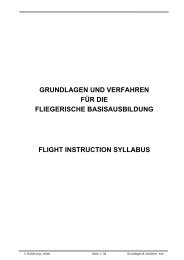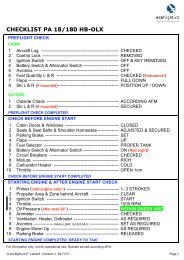Pilot Operating Handbook - Ecoflight.ch
Pilot Operating Handbook - Ecoflight.ch
Pilot Operating Handbook - Ecoflight.ch
Create successful ePaper yourself
Turn your PDF publications into a flip-book with our unique Google optimized e-Paper software.
Rev. 02 – July 16 th , 2009<br />
7 Normal Procedures<br />
7.3 Descent and Landing<br />
After the glider has released the rope and prior to descent, it is<br />
recommended to close the oil temperature regulation flap (position<br />
"closed/warmer"). Special care has to be taken to keep all<br />
temperatures within the permissible range. If required to keep<br />
temperatures at proper operation levels, the throttle may be left at a<br />
setting just above the idle position.<br />
Before descent, it may be necessary to retract flaps to establish<br />
cruise configuration (flaps up, 0°), otherwise the maximum<br />
permissible descent speed of V FE,max. = 81 mph (70 knots) must not<br />
exceed!<br />
Before landing on hard surface, the tow rope shall be released at a<br />
safe altitude (~150 ft AGL) to avoid damages of rope and its<br />
atta<strong>ch</strong>ments. Landing on grass with rope still coupled to the aircraft<br />
is possible without damaging the rope. Nevertheless, for safety<br />
reasons landing with rope is not recommended.<br />
Final approa<strong>ch</strong> with the tow rope still connected to the release clut<strong>ch</strong><br />
must be carried out with a steep approa<strong>ch</strong> angle. The rope will hang<br />
down significantly from the aircraft due to its own weight. Therefore it<br />
can interlock with obstacles, plants, wires, vehicles, persons, etc.<br />
Safe operation of the aircraft is not ensured in this case. By this<br />
accidents may occur causing severe injury or even death.<br />
Towing Glider Supplement 10.2 - 13










